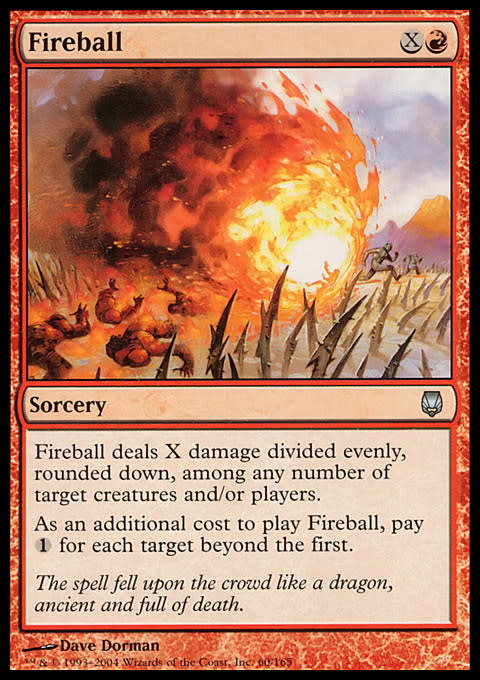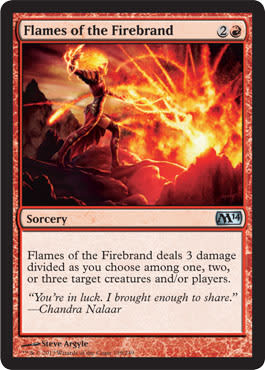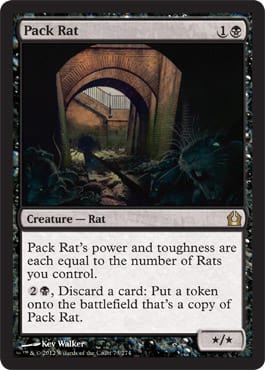Quentin Martin recently wrote an article about how to improve Magic. And while I don't necessarily agree with all of his points, there is one statement I do absolutely agree with: “These tournaments are getting too big.” When I first started playing in these tournaments (2005), there were only a few hundred players. In fact, the cut to Day 2 was decided by a simple rule: If the number of players was fewer than eight hundred, the Top 64 players would advance. Otherwise, the Top 128 players would advance. At that time, it was fairly rare to see over eight hundred players. I think the first Grand Prix I played in that actually broke the eight-hundred barrier was Grand Prix: New Jersey in 2006. Nowadays, it's quite common to see these tournaments have over a thousand players. They've even hit over two thousand a few times.
For me, this came to a head at the last Grand Prix in Toronto, wherein we had to play ten rounds of Sealed. Ten! To me, that's insane. Even with three byes, it's really, really hard to not pick up more than two losses over that many rounds, especially in a format like Sealed. With the way these tournaments are currently structured, competitive players like me are less likely to be inclined to travel to them. The most likely source of the increased growth is from the growth in the overall player base. I'm certainly not going to argue that this is a bad thing, but something has to be done to make these tournaments more manageable. Continually increasing the number of rounds Day 1 seems to me an inefficient and unsustainable solution. What happens if the growth in players continues at its current rate? Will I one day have to deal with the prospect of playing twelve rounds on Day 1?
Martin proposes raising the entry fee to reduce the number of players, arguing that an increased demand should lead to an increase in price. I think that’s the wrong approach for a couple of reasons. First, without being too technical, it’s going to depend on the elasticity of demand, or in other words, how responsive people are to a change in price. If people are highly sensitive to an increase in price, you will see them spending their money on cheaper substitutes when the price of a Grand Prix entry increases even a little. I’m sure that Wizards of the Coast has financial analysts working for them who are smart enough to figure out what the right price to charge for their products in order to maximize their profits. Second, Grand Prix tournaments are meant to be open to everyone. They are designed to be the highest level of competition for the amateur player (i.e. not Pro Tour players). Raising the entry fee to $100, for example, runs contrary to that philosophy. So, the question becomes: How do we reduce or cap the number of rounds on Day 1 without reducing the number of players?
Before I answer that question, I'm going to go on a bit of a tangent. Once upon a time, I played in Street Fighter tournaments. The big show for that scene is Evolution. It's something of a world championship for fighting games, but as far as a tournament philosophy goes, it's similar to a Grand Prix in Magic. It's not an invite-only tournament, it's open to everyone. Now, Street Fighter tournaments are structured very differently than Magic tournaments. In Magic, the only real constraint on the number of matches you can have going on at the same time is how many tables you have. In Street Fighter, you're constrained by how many arcade cabinets (I guess these days, they use TVs and consoles) you have. A Swiss-style tournament is impractical for Street Fighter because you can't have everyone playing their matches at the same time. For that reason, almost every Street Fighter tournament I played in was double-elimination: You lose twice, you're out. Next to single-elimination, which we're all familiar with from our Top 8 cutoffs, double-elimination is the most efficient way to decide the winner of a tournament. That worked fine for regional tournaments, but the sheer number of players at Evolution made a straight double-elimination structure a logistical nightmare. This is why the tournament organizers introduced the idea of Day 1 qualification pools. When you signed up for Evolution, you were assigned to one of a certain number of qualification pools, and a certain number of players from each pool advanced to Day 2 (I forget the exact numbers, but you get the idea). This was done so that players on Day 1 wouldn't have to wait several hours between matches and so that they could have a set number of players for the Day 2 double-elimination bracket.
Back to Magic, here's what I'm proposing: Day 1 will consist of qualification pools similar to what I described about but with a few key changes that I'll describe in a moment. Day 2 will be fixed at sixty-four players. Here's how Day 1 will work:
Instead of Day 1 being a giant Charlie Foxtrot, it will be split up into eight “pools.” At a maximum of two thousand forty-eight players, the number of players per pool would be two hundred fifty-six, the magic number for an eight-round tournament. For tournaments with over two thousand forty-eight players, adding a round brings the maximum number of players per pool to five hundred twelve, which allows for up to four thousand ninety-six players. No Grand Prix has even come close to that number, so this shows the robustness of the structure.
After Day 1 concludes, the top eight players from each pool advance to Day 2, where their match points carry over.
This structure has a number of advantages:
- As stated before, it is very robust. It keeps the number of rounds on Day 1 to eight for all but the largest of Grand Prix tournaments. Going to nine rounds in extreme cases would account for any conceivable tournament in the near future, assuming the growth rate of players stays relatively stable.
- It still has that Grand Prix feel without being completely overwhelming. Doing it this way arguably makes advancing to Day 2 harder since not everyone with a 6–2 record will make it. However, the payoff for making Day 2 is much better. Too often, I see people limp into Day 2 with an X–2 record only to be put into a position in which they must go 6–0 to make Top 8. Making Day 2 is meaningless if you’re just fighting to make Top 64 and win a couple hundred bucks. In this system, everyone who makes Day 2 has a legitimate shot of making Top 8 and is guaranteed a minimum payout.
- It is much easier to run. Since each pool is self-contained, you don't run into the logistical problems of running huge tournaments. I'm willing to bet that eight Pro Tour Qualifier–sized tournaments run faster than a sixteen-hundred-person Grand Prix. From a judging and scorekeeping perspective, this tournament structure seems to be more attractive, but as I'm not involved with that aspect of Magic tournaments, I invite those who are to comment.
There are a few criticisms I can anticipate, which I will also try to answer here:
Isn’t This Just Turning Day 1 into a Bunch of PTQs?
Yes and no. Because your record carries over to Day 2, fewer people are going to intentionally draw. Someone who starts 6–0 isn’t going to draw twice to lock himself into Day 2; he or she will want to play out at least the next round to put him- or herself into a better position. I’m sure people will still draw in situations in which both players are in with a draw and out with a loss, but that was also the case in Grand Prix tournaments of old—before the automatically-Day-2-at-X–2 rule.
What about Byes?
I actually thought a lot about how to incorporate byes into this system. I’m of the opinion that Grand Prix Trials are something of a joke now that any store can run them. It’s very easy to win three byes to a nearby Grand Prix if you’re determined enough and are a halfway-decent player. While I don’t think byes should necessarily be abolished altogether, I do think they should be restricted to Pro Players Club members. Byes in this sort of tournament are a much bigger advantage, so I definitely think they should be restricted. What I’m thinking is that Platinum-level players should receive one bye. Three byes are just too many. There are only about twenty-five or so Platinum players, and even assuming they all play in a Grand Prix, that’s still about three players per pool who have a bye, so it shouldn’t throw things off by much.
What If all the “Good” Players End Up in the Same Pool?
This is actually a really easy problem to solve. Statistically speaking, you would expect an even distribution of player skill across all pools. There is a way to ensure that through player seeding. Back when I ran Street Fighter tournaments, I would often seed players by region. No one likes to drive a long distance just to play someone in his car in the first round. I would typically try to make sure that players from the same area weren't clustered together in the bracket. Whom you face in a single- or double-elimination tournament is a deterministic process: You know that if you win, you will face the winner of the match adjacent to you in the bracket. In a Swiss tournament, it's a stochastic process: Your opponent each round is randomly determined conditional on your match points. Still, the methodology is the same: Take some characteristic (say Pro Level) and ensure that characteristic is distributed evenly. It would not be hard to develop an algorithm to randomly assign players to pools while ensuring whatever distribution you want.
What about Smaller Grand Prix Tournaments in More Remote Regions?
That’s a fair point actually. Grand Prix tournaments in Australia, for example, have relatively few people. I think the current Grand Prix system is fine for those tournaments, and I’m only proposing this change for very large events as an alternative to having nine or more rounds on Day 1.
Because of my affinity for crunching numbers, I actually computed the expected number of players in a Grand Prix over 2012. Overall, it was one thousand fifty-seven. I also looked at the expected number of players conditional on region, and the numbers for the main three regions look like this:
- North America: 1,127
- Europe: 1,233
- Asia: 1,037
That means that for most Grand Prix tournaments, you can expect around eleven hundred players—a little more for Europe, and a little less for North America. Using this structure for a typical Grand Prix, such as Minneapolis, which had one thousand fifty players, each pool would have a hundred thirty one or a hundred thirty-two players. The largest Grand Prix was Philadelphia, with nineteen hundred eight-three players. That's still around two hundred forty-eight players per pool. More importantly, that's still eight rounds. You could make the argument here that Shuhei Nakamura lost twice early in Day 1 and came back to win the tournament. I would counter that by saying that he had to win fourteen rounds in a row to do it. How many Magic players in the world are capable of doing that? Not very many I would venture. For every Shuhei out there, there are hundreds of Magic players who limp in at X–2 each year who barely make Top 64, much less Top 8.
Wrapping Up
So, to summarize, this structure is superior to the current one for large tournaments in the following ways:
- Robustness – Eight rounds of Day 1 play suffices for up to two thousand forty-eight players. Adding a round accommodates up to four thousand ninety-six players.
- Payoff – The increased difficulty of Day 1 is met with an increased reward for Day 2. Making Day 2 is special and rewarding in of itself (as it should be).
- Promise – Everyone who makes Days 2 is “live.” No one is limping in with a small chance of success.
There’s certainly room to change the details—this is just a proof of concept of sorts. I’m hoping that some of these ideas make it to whoever is in charge of deciding these things. Feel free to comment below if you think this is a great idea, if you think this sucks, or anything in between. And if you have your own ideas about how to improve Grand Prix tournaments, I’d love to hear them as well. I’d like to see some discussion going, as I really do think these events need to adapt to the growing number of players.
Until next time,
Nassim Ketita
arcticninja on Magic Online

























